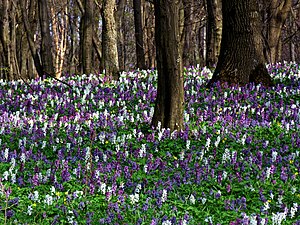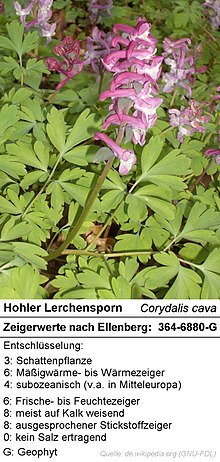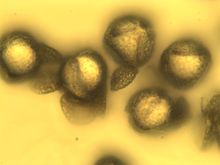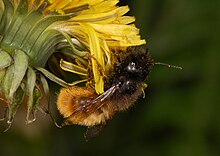Hollow lark spur
| Hollow lark spur | ||||||||||||
|---|---|---|---|---|---|---|---|---|---|---|---|---|

Hollow Larkspur ( Corydalis cava ) |
||||||||||||
| Systematics | ||||||||||||
|
||||||||||||
| Scientific name | ||||||||||||
| Corydalis cava | ||||||||||||
| ( L. ) Schweigg. & Kits |
The hollow lark spur ( Corydalis cava ), also known as bulbous lark spur and partly also shaggy pants, is a species of the genus lark spurs ( Corydalis ) in the poppy family (Papaveraceae). The botanical name is derived from the Greek word (κορύδαλις korýdalis) for Crested Lark from, as the flower shape resembles spurred toes of this bird. The German trivial names Hohlknolliger Lerchensporn and Hohlwurz also refer to it. The type epithet cava is derived from the Latin word cavus for hollow and refers to the hollow tuber. All parts of the plant are weak, but the rhizome tuber is highly poisonous; this contains alkaloids as ingredients , for example bulbocapnin .
description

Appearance
The hollow lark spur is a perennial herbaceous plant that reaches heights of 15 to 30 centimeters. Name-giving and characteristic of the hollow lark spur is its spherical, walnut-sized tuber , which surrounds a cavity in which one or two daughter tubers develop in older plants. It serves as an underground storage and persistence organ, with which the hollow lark spur is counted among the geophytes . At the beginning, the tuber is a stem tuber emerging from the hypocotyl - the stem axis area between the root neck and the first cotyledon. This increases gradually, the growth in thickness being stronger than the growth in length. Older parts of the bulb are shed. The upright and unbranched stem has a fleshy consistency. All parts of the plant are bare.
leaf
The stalked leaves, which are basically in twos, are arranged in alternate leaf positions on the stem. The blue-green colored leaf blade is doubly tripartite with several incised pinnate sections. There are no scaly lower leaves below the lower leaf .
Inflorescence and flower
The variably colored, slightly fragrant flowers of the hollow lark spur develop between March and the beginning of April. Each population includes roughly equal parts purple to purple and white flowering specimens. Ten to twenty flowers are close together in a terminal, all-round , racemose inflorescence . Below each flower there is an oval to egg-shaped, whole-margined bract . In contrast to the fingered larkspur ( Corydalis solida ), this one is undivided. The hermaphroditic, transverse dorsiventral single flower is about 2 to 3 centimeters long. The hollow lark spur has a calyx and a crown . The two inconspicuous sepals are obsolete, they fall off shortly after blooming. This is followed by two outer and two inner petals. Of the two outer petals, the upper one forms the upper lip . The upper lip is broadened towards the front and ends in the rear area in a two to three centimeter long, hook-shaped curved spur . A basal, common extension of the upper stamens (also known as the nectar spur) extends into the flower spur and secretes nectar. The flower spur carries abundant nectar and especially attracts long-nosed insects to pollinate. The lower outer petal forms the lower lip , which is also widened at the front . The two smaller, laterally standing inner petals are whitish. They have grown together at their tips and thus form a hood that tightly encloses scars and stamens. The ovary is on top. Of the six stamens , three stamens have grown together to form a bundle of stamens. In both bundles, the middle anthers are equipped with two pollen sacs . The dust bags standing on the side only carry a pollen sack.
The flowers are self-fertile . The plants are only capable of flowering in the 4th year.
Fruit, seeds and germination
A multi-seeded, pale green pod-shaped capsule develops on a 6 to 7 millimeter long stem . In contrast to the pods of cruciferous vegetables, it does not have a (false) partition. The pod hangs down when ripe and measures about 2.5 centimeters. As early as May, the capsules open by means of two flaps and release the seeds. The almost spherical, glossy, black seeds are equipped with a strikingly whitish elaiosome . In the soil, the seeds go through a post-ripening phase, during which the embryo grows to its full size. Although the hollow lark spur belongs to the dicotyledonous plants , it germinates with only one cotyledon . The seeds are cold germs .
Chromosome number
The basic chromosome number is given as n = 8, with the subspecies ssp. marshaliana but with 2n = 32.
Similar species
The hollow lark spur ( Corydalis cava ) can also be confused with the following species on cursory inspection:
- Fingered lark spur ( Corydalis solida ): The bracts below each flower are fingered on this one, but undivided on the hollow lark spur.
ecology
The hollow lark spur is a spring green tuber - geophyte , the aboveground parts of which wither early and no longer exist in summer. This behavior is an adaptation of the plant to the heat and light balance of the deciduous forest, derived from the vegetation rhythm of related steppe plants.
pollination
From an ecological point of view, these are homogeneous "butterfly flowers"; as the upper petal is spurred, the flower looks zygomorphic . Usually red-flowered and white-flowered plants occur side by side; in the majority of the red-flowered forms the flowers are rotated by 90 °; this has resulted in a so-called “intelligence flower”, in which only hymenoptera who are gifted in learning are able to find and open the unusual flower entrance. Pollination is usually done by long-nosed bees. They suck the nectar out of the long spur through the flower opening, which is released at the base of the stamens. It has also been observed that honeybees can easily absorb nectar from flowers that are tilted slightly downwards. Short-nosed bumblebees appear as honey robbers - typical of long-spurred plants. In order to get the coveted food, they bite the spur from the outside and take in nectar without serving for pollination.
The nectar of the hollow larkspur is a valuable source of food in early spring, especially for long-nosed bees. The horned mason bee appears particularly frequently on the flowering plants.
Spread
The hollow lark spur has various mechanisms to ensure that it spreads: Since the seeds fall to the ground when the fruit is ripe, gravity spreads. Since the shiny black seeds have a conspicuous white elaiosome , ants also spread ; the ants carry the seeds into their burrows on the sticky elaiosome. The hollow lark spur uses vegetative reproduction via daughter tubers, in a broad sense a form of self- propagation .
Synecology
From the leaves of the caves Lerch spur eat oligophagous the caterpillars of the endangered black Apollo butterfly .
The hollow lark spur is attacked by the rust fungus Melampsora magnusiana with spermogonia and aecidia .
Distribution and site conditions
The hollow larkspur is a central European floral element . Its distribution area coincides with the area of the beeches , only in the east the hollow larkspur extends beyond it, the species there goes to Moscow and to the Crimea ; in the west it avoids the Atlantic climates; in the south its area extends to southern Italy and Macedonia. The hollow larkspur is widespread in Central Europe . In the south it is native to the Pyrenees , southern Italy and Greece . It is naturalized in England , Denmark and southern Sweden . No stocks have been known from Norway , Finland and large parts of the Mediterranean region. It is absent in the Central European lowlands, in the low mountain ranges with lime-poor rock, in the Alpine foothills and in the Alps with lime-poor or lime-free rock in larger areas. In the Allgäu Alps, it rises in the Obergelchenwangtobel on the Hochgrat in Bavaria up to 1500 m above sea level.
The hollow larkspur reaches its largest occurrence in Germany in Bavaria. In north-east Germany the population density is given as scattered, in the north-west the hollow lark spur is only rarely found.

The hollow lark spur thrives best on slightly moist, loose, muddy, humus-rich and nutrient-rich loam soil .
The hollow lark's spur is considered to be an order character of the mesophytic beech and deciduous forests. It is particularly found in herbaceous beech and oak forests, in beech and hornbeam forest communities, in linden and maple forests or even hardwood floodplain forests , bushes and hedges . The main distribution according to Erich Oberdorfer is given as subcontinental (species with a focus on Eastern European deciduous forest areas, which are absent on the coasts as well as in the Asian deciduous forest areas). As a nutrient and clay indicator , the hollow larkspur prefers fresh, nutrient-rich and loose clay and limestone soils in sufficiently moist and warm places. The hollow lark spur mostly occurs in larger, but rarely stock-forming groups. In Central Europe it is the most common type of lark spur and in deciduous forests with nutrient-rich, humus-rich soils, its white or light red flowers often dominate the scene with the beginning of spring. According to the ecological indicator values according to Ellenberg , the shadow plant indicates a warm, moderate maritime climate and evenly moist areas. It also suggests soils rich in lime and nitrogen.
Systematics
The following subspecies are found in Europe at Corydalis cava (L.) Schweigg. & Körte differentiated:
- Corydalis cava subsp. cava
- Corydalis cava subsp. blanda (Schott) Nyman , occurs only in Greece, Albania and the former Yugoslavia; is even considered by some authors as a separate species Corydalis blanda Schott .
- Corydalis cava subsp. marshaliana (Pallas) Chater , occurs in Eastern and Southeastern Europe.
toxicology
All parts of the plant of the Hollow Larksporn are poisonous, but especially the tuber.
The main active ingredients differ depending on the location: The dried tuber contains 5 to 6% alkaloids , the fresh one contains more than 2% . The highest alkaloid content was found at the beginning of flowering. The main alkaloid is corydalin along with 20 other compounds, including bulbocapnin , corybulbin , isocorybulbin , corypalmin and tetrahydropalmatine .
Symptoms of intoxication: Bulbocapnin produces a catalepsy-like lack of movement up to and including the abolition of voluntary and reflex movements without the muscles becoming rigid. The ability to absorb sensitive stimuli is retained. A larger dose is also hypnotic.
Tetrahydropalmatine has sedative-tranquilizing properties according to recent studies.
use
The hollow larkspur is also preferred as an ornamental plant in near-natural gardens.
The hollow larkspur as a medicinal plant
The perennial rhizome tuber contains alkaloids, most of which are bulbocapnin. With an intact absorption capacity for sensitive stimuli, these active ingredients cause a paralysis of the muscles. A total extract has a slightly sedating effect. If the drug is used as intended, side effects are not to be expected.
Both the hollow lark spur and the pipe flower Aristolochia rotunda L. were referred to as Hohlwurz and were also interchangeable with regard to their healing indications.
Common names
The other German-language trivial names Biberwurz, Biverwurz, Buchs ( St. Gallen near Werdenberg ), Donnerfluch, Donnerflug, Donnerwurz, Erdkraut ( Silesia ), Knolliger Erdrauch, Frauenschüchlein (Thuringia, Alsace ), Frauenschuh (Silesia) exist or existed for the hollow lark spur , Leipzig ), Giggerihaner ( Tirol im Pongau ), Guli (St. Gallen), Hahnenspor, Hahnensporn, Hahnenvoz (in the sense of buttercup, Old High German ), Rote und Weiße Hahnen (Tirol im Pongau), Halewurtz ( Middle High German ), Hellewurtz (Middle High German ), Helmwurz (Silesia), henna (St. Gallen), red and white hens ( Zillertal ), Herzwurz, red and white Höseln (St. Gallen near Werdenberg), Hohlwortel, Hohlwurz ( Switzerland ), Hohlwurz, Hohlwurzbohnen, Hoilwurz, Jerdapelcher ( Transylvania ), Lerchenhelm, Larkkraut, Larksporn, Snapdragon , False Osterluzei, Oestrich ( Eichsfeld ), Pfifferrösli (Switzerland), Puetshecken (Switzerland), Rösli ( Bernese Oberland ), Rossthräni ( Lucerne ), Taubenkrop f, walburg herb and onion smoke.
- Illustrations
Sources and further information
The article is mainly based on the following documents:
- Oskar Sebald : Guide through nature. Wild plants of Central Europe. ADAC Verlag, Munich 1989, ISBN 3-87003-352-5 .
- Dumont's great herb encyclopedia , DuMont Cologne 1998, ISBN 3-7701-4607-7
- Werner Rothmaler : Excursion flora from Germany. Vascular plants , basic volume, Spektrum-Verlag ISBN 3-8274-1359-1
- Stingl, Wagner, Haseder, Erlbeck: Das Kosmos Wald- und Forstlexikon , Kosmos-Verlag, ISBN 978-3-440-10375-3
- Richard Wettstein : Handbook of systematic botany , 1924 on Kurt Stueber.
Individual evidence
- ↑ a b c d e f Dr. Dietrich, Dr. Heinrich: Frühblüher um Jena , EchinoMedia Verlag, ISBN 978-3-937107-15-8 , pages 106–110.
- ↑ a b Botanical Garden Erlangen of the University of Erlangen - Nuremberg: Medicinal plants , p. 73f.
- ^ A b Gustav Hegi : Illustrated flora of Central Europe . 2nd edition Volume IV, Part 1, Carl Hanser Verlag, Munich 1958, p. 38 ff.
- ↑ a b c d e f Ruprecht Düll, Herfried Kutzelnigg: Pocket dictionary of plants in Germany and neighboring countries. The most common Central European species in portrait. 7th, corrected and enlarged edition. Quelle & Meyer, Wiebelsheim 2011, ISBN 978-3-494-01424-1 .
- ↑ a b Ruprecht Düll , Herfried Kutzelnigg : Pocket dictionary of plants in Germany. A botanical-ecological excursion companion to the most important species. 6th, completely revised edition. Quelle & Meyer, Wiebelsheim 2005, ISBN 3-494-01397-7 , p. 144 ff.
- ↑ G. Tischler: The chromosome numbers of the vascular plants of Central Europe . 's-Gravenhage, junk. 1950.
- ↑ Thomas Gaskell Tutin et al. a .: Flora Europaea . 2nd edition, Volume 1, page 304. Cambridge University Press 1993
- ↑ Oskar Sebald: Guide through nature. Wild plants of Central Europe. ADAC Verlag, Munich 1989, ISBN 3-87003-352-5 , p. 36.
- ↑ Peter Zwetko: The rust mushrooms Austria. Supplement and host-parasite directory to the 2nd edition of the Catalogus Florae Austriae, III. Part, Book 1, Uredinales. (PDF; 1.8 MB).
- ^ Oskar Sebald, Siegmund Seybold, Georg Philippi (ed.): The fern and flowering plants of Baden-Württemberg. Volume 1: General Part, Special Part (Pteridophyta, Spermatophyta): Lycopodiaceae to Plumbaginaceae. 2nd, supplemented edition. Eugen Ulmer, Stuttgart 1993, ISBN 3-8001-3322-9 .
- ↑ a b Dietmar Aichele, Heinz-Werner Schwegler: The flowering plants of Central Europe. Volume 2: Yew plants to butterfly plants. Franckh-Kosmos, Stuttgart 1994, ISBN 3-440-06192-2 .
- ↑ Erhard Dörr, Wolfgang Lippert : Flora of the Allgäu and its surroundings. Volume 1, IHW, Eching 2001, ISBN 3-930167-50-6 , p. 567.
- ↑ a b c Jaakko Jalas, Juha Suominen: Atlas florae europaeae . Volume 9 (Paeoniaceae to Capparaceae). Pages 67-69, Helsinki 1991. ISBN 951-9108-08-4 .
- ↑ a b c d Lutz Roth, Max Daunderer, Kurt Kormann: Toxic Plants - Plant Poisons. Occurrence, effect, therapy, allergic and phototoxic reactions. With a special section about poisonous animals. 6th, revised edition, special edition. Nikol, Hamburg 2012, ISBN 978-3-86820-009-6 .
- ↑ Eva Shenia Shemyakova: 'Des Juden buch von kreuczenach'. Investigation and edition of the recipe part of the Heidelberg Cpg 786. In: Fachproseforschung - Grenzüberreitungen. Volume 8/9, 2012/13, pp. 207-265, here: pp. 229 f.
- ^ Georg August Pritzel , Carl Jessen : The German folk names of plants. New contribution to the German linguistic treasure. Philipp Cohen, Hannover 1882, p. 114. ( online ).
further reading
- An incomparable work of art. In: Reinhard Junker , Richard Wiskin: In the spring forest - on the trail of nature. A discovery book for young and old , Dillenburg, 2002, ISBN 3894363088 , pp. 32-35
Web links
- Hollow lark spur. In: FloraWeb.de.
- Hollow lark spur . In: BiolFlor, the database of biological-ecological characteristics of the flora of Germany.
- Profile and distribution map for Bavaria . In: Botanical Information Hub of Bavaria .
- Corydalis cava (L.) Schweigg. & Körte In: Info Flora , the national data and information center for Swiss flora . Retrieved October 22, 2015.
- Distribution in the northern hemisphere
- Thomas Meyer: Data sheet with identification key and photos at Flora-de: Flora von Deutschland (old name of the website: Flowers in Swabia )
- The poisonous plant Hohler Larksporn.
- Entry in Plants for a Future. (engl.)
- The species from a horticultural point of view. (German)












